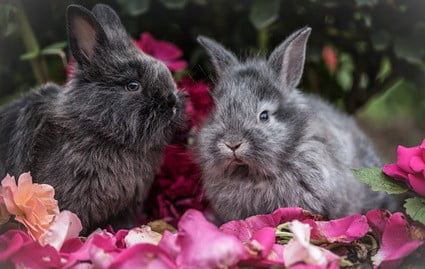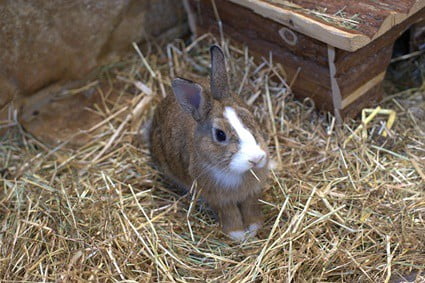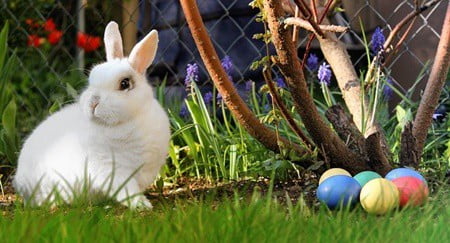Rabbits are known for their nibbling and chewing. You may have noticed your pet bun munching on its towel, blanket, or even a piece of clothing left on the floor. Unfortunately, rabbits are simply falling prey to their curious instincts. They don’t understand that the material is harmful for them.
Rabbits should not eat fabrics. This is because fabrics can easily cause an intestinal blockage. Because of how their digestive tract works, intestinal blockages can become life-threatening for rabbits. In serious cases, rabbits will need surgery to remove the blockage.
Thankfully, there are ways you can prevent your rabbit from chewing fabric. This includes providing chew toys, training, and spaying or neutering. Should your rabbit be persistent in chewing fabric, you should pick the safest materials to expose it to. This mainly includes polar fleece for its enclosure, to help mitigate some of the risks.
Can Rabbits Eat Fabric?
As a rule of thumb, rabbits should not eat fabric. There is clearly no nutritional value to eating fabric.
Rabbits will not understand this, however. Curious bunnies will often explore their cage or your home by tasting and smelling items. If they discover a flavor they enjoy in their blanket, they may consume a portion of it. This can cause a great deal of harm to their bodies.
Why Rabbits Cannot Eat Fabric
Of all the health concerns, your rabbit will face the most danger from intestinal blockages. However, there are many, smaller problems your bunny will experience if it regularly consumes fabric.
Fabrics Are Often Synthetic
Fabrics are unsafe primarily because of how the material is designed. Many are blended with synthetic components, which can build obstructions in your rabbit’s gut.
As such, a wild rabbit may chew on a cotton blossom in a field. However, that’s far different from the blankets or towels you have in your home. There is a good chance that the fabric your rabbit has eaten is made of synthetic materials.
Because it is cheaper, artificial fabrics are more readily available and easier to buy. Even natural fibers, like cotton, are often blended with synthetic components to prolong their lifespan. This can become a problem for your rabbit. In the stomach, synthetic materials cannot be digested.

Fabrics Can Easily Become Tangled
Whether synthetic or entirely natural, fabric fibers can easily become tangled up in a ball. A fiber’s ability to tangle is actually a great characteristic. The more prone to tangling they are, the more durable and insulating they will be as a fabric. However, this can be a problem when stuck in a rabbit’s body.
If your rabbit consumes fabric with “good” fibers (as with most towels, blankets, and pieces of clothing), that creates a problem. The fibers are likely to knot up and create a large ball inside of your rabbit.
This can make it difficult for its intestines to push along. When this happens, other food or waste will be unable to pass as well. That could lead to illness or even death.
Rabbits Are Prone To Digestive Issues
Rabbits are susceptible to digestive issues, as most veteran rabbit owners will know. This is due to the unique set-up of a rabbit’s gut and intestines.
Plant fibers are digested in the stomach and move into the colon. However, any digestible fibers are formed into a softer type of poop called caecotrophs. In this way, rabbits can consume and process these stray nutrients a second time to remain healthy.
Because of this unique set-up, it’s more likely for your rabbit to experience blockages. If its diet is kept healthy and balanced, it will operate fine. However, if it eats fabric – prone to tangling and impossible to digest – it’s a perfect storm.
Rabbits Can’t Vomit
To make matters worse, rabbits cannot be induced to vomit. Inducing vomit is one of the go-to ways to treat blockages in animals. After all, if a blockage has already passed through a certain portion of the gut, it can likely pass back through that portion again.
However, rabbits are physically incapable of vomiting. These animals do not have a gag reflex. Even if they did, their digestive muscles are too weak to regurgitate food.
Because rabbits cannot vomit, intestinal blockages can easily become life-threatening. According to Ferrets, Rabbits, and Rodents, blockages often need “aggressive medical and in some cases surgical therapy.”
Surgery is often saved as a last-ditch effort when treating animals. This is because surgery often creates many other complications. However, in serious cases, this can be the only option for rabbits.
Intestinal Obstruction Symptoms
That isn’t to say you need to ban all fabrics from your rabbit cage or house. A chew here and there won’t kill your rabbit. Some rabbits may show indifference to fabric altogether after getting a taste.
However, you should always keep an eye out for your rabbit if it has eaten a considerable amount. Symptoms of intestinal blockages include:
- Anorexia, or loss of appetite
- Teeth grinding, or bruxism
- Bloated abdomen
- Less poop
These symptoms often occur suddenly. If you notice these signs, contact your vet immediately for a diagnosis.
Is Wool Safe for Rabbits?
Wool refers to any type of fiber that comes from the under-hair of animals. Specifically, this under-hair is a type of fur that grows continually. It is soft, thin, pliable, and flexible. Wool commonly comes from sheep, but other animal hair can be made into wool. This includes goats and the muskox.
Wool is an expensive fabric, but there are many advantages to it. It is very durable and can be used in many ways. According to the Research Journal of Textile and Apparel, wool may even have antibacterial properties.
If you were to buy natural wool, would it be safe for your rabbit? Unfortunately not, because of wool’s ability to “crimp.” Of all its characteristics, wool fibers are best known for their excellent ability to insulate. This is mostly due to the wool’s “crimp.” Crimp refers to the waviness of each individual wool fiber.
This waviness lets the fibers attach to each other. As a result, we get very bulky fabrics. This bulk gives insulating properties to the material, since it can better trap heat. On top of that, wool is highly thermal resistant, so it’s good at stopping heat transfer. This makes it a preferred clothing material for people in hot, desert climates.
Unfortunately, this ability to crimp is the reason why wool is unsafe for rabbits. The “crimping” increases the wool’s ability to clump together. When this happens inside a rabbit’s stomach, it can spell disaster.
Wool Breeds
Ironically, there are rabbits bred for wool. These types of bunny are called wool breeds. While you might imagine they’re highly resistant to intestinal blocks, out of necessity, that’s incorrect.
Wool breed rabbits are likely to suffer from a condition called wool block. This happens when a rabbit ingests its own hair, which “crimps” and forms a hairball. They cannot gag it up like cats. Non-wool-breed rabbits can safely eat their own hair, but this breed does not have thin, light hair that’s passable.
Instead, the density of their fur is prone to blockages – like the fabric it will eventually become.
Is Felt Safe For Rabbits?
Despite popular belief, “felt” isn’t a term used to describe what a fabric is made of. Instead, it refers to how the fabric is created. This is done through a process called felting. It involves matting, condensing, and pressing fibers together. The end result becomes a piece of fabric that can be cut, sewn, and decorated like any other material.
The very nature of felting is why it’s dangerous to your rabbit.
Long Fibers
Felted fibers are naturally long fibers. This makes it easy for them to cling to one another, and tangle inside your rabbit.
Short fibers, which are safe for rabbits, cannot be felted. Because of their short length, they will not bond with other fibers. If they can’t do that, the resulting fabric will easily fall apart.
Synthetic Fibers
As mentioned, synthetic fibers are dangerous for rabbits to eat. However, felt has an extreme degree of synthetic ingredients, making it even more dangerous. Chances are, your felt is made with acrylic or rayon.
Felting makes it easy to blend fibers. Manufacturers often take this chance to make their felt extra durable, while still cheap. This makes felt an easily accessible fabric, but it can cause harm to your pet.
Acrylic and rayon are non-nutritious. Likewise, they can cause a blockage. Worst of all, they may even be toxic for your rabbit to consume in large amounts.
Is Polyester Safe for Rabbits?
Polyester is perhaps the safest fabric for a bunny. This is because it isn’t made of fibers, like other types of fabric. Instead, it is made of plastics. This is the reason why polyester has a bad reputation in fashion circles.
Polyester cannot wick moisture. This means that sweat will not pass through the plastic material. This makes for a very uncomfortable piece of clothing, especially in hot climates and for sportswear. Secondly, polyester is not environmentally friendly.
Recently, there have been developments that address both issues. There are polyester fabrics that now have moisture-wicking capabilities. Most polyester fabrics are made with recycled PET bottles. PET plastics are inherently not biodegradable.
What does this mean for your rabbit? This means that polyester is much safer for your rabbit’s digestive system. Unlike other materials, polyester is not made with fibers. Instead, it is made with polymer plastics. This is not the healthiest thing for your rabbit to eat, of course. But it will have less chance of creating blockages in your rabbit’s stomach.
With that said, don’t leave your rabbit alone to munch on polyester. Polyester is still an unhealthy material that bunnies should not eat. If you have to pick from two evils, however, polyester is a safer option. If your rabbit eats a few bites, it will be fine. If it eats a large amount, that’s still bad for its health – but not immediately life-threatening.
Blended Polyester Fabric
To make polyester more accessible to humans and easier on the environment, it’s sometimes blended with other fabrics. The most common type is a cotton-polyester blend. This makes a material that’s comfortable, with fewer downsides from pure polyester.
When it comes to rabbits, that’s a problem. Cotton fabrics can develop as blocks in your rabbit’s stomach. While the inclusion of polyester does lower the chances, it’s still more dangerous than if the fabric was pure polyester.
When choosing blankets or towels to expose your rabbit to, be sure to check the label. Is that bedding going to be 100% polyester or a blend?
Why Rabbits Eat Fabric
It is a common behavior of rabbits to eat fabric. As a matter of fact, it’s natural for rabbits to eat many things they shouldn’t. Whether its wires, or plastic, or wood, or even their hutch, rabbits sink their teeth into anything. Fabric is just one of many things you should limit your rabbit’s unsupervised contact with. But why does your rabbit chew so much?
Biology
Rabbits are biologically wired to want to chew. This is because their teeth do not stop growing. Rabbits will have a natural urge to wear down their teeth, in order to avoid complications. As most rabbit owners know, rabbits tend to encounter many painful issues with their teeth.
Boredom
All animals need stimulation and enrichment. When they do not have enough of both, they will engage in base behaviors. For rabbits, this often means chewing.
Bored rabbits will also try to catch the attention of their humans. If your pet bun has your focus, it has the chance of getting playtime. Whether that playtime comes from you, or from a toy, chewing is an excellent way to catch your attention.
Fabric becomes a common victim of this behavior. Blankets, shirts, and even sofas are easy to reach and grab onto. Sometimes, it’s the only accessible material nearby. Unfortunately, it can be very harmful for your rabbit.
Domestic Misunderstanding
It seems strange that your rabbit doesn’t know what’s bad for it, like in the wild.
However, domestic rabbits do not have their wild counterpart’s intuition. They have been separated from the great outdoors for generations. Likewise, with no prior exposure itself, your rabbit will not be as discerning about food. This leads to your pet bun munching on a blanket that could ruin its – and your – day.
Pica Behavior
Chewing is a common behavior in rabbits. However, there are instances where it is more serious than it looks. That is when chewing becomes a compulsive behavior.
Compulsive chewing is referred to as pica, specifically if it involves craving inedible objects. Rabbits who exhibit pica behaviors commonly chew items like paper, wood, and, of course, fabric. Pica is an issue by itself, but it can also be a symptom of a worse illness. For example, a rabbit exhibiting pica behaviors can be suffering from enteritis. This refers to an inflammation of the intestines.
Not all chewing behaviors are considered pica. Pica often appears suddenly, with little to no explanation. If your rabbit suddenly chews excessively, think about contacting your vet.

Rabbits Eating Towels
Because it is prone to chewing, your rabbit will probably munch on its towel. After all, the bun will have easy access to the material.
However, towels are usually made of cotton fibers. While it’s not the worst material for your rabbit, it can still cause blockages.
Nonetheless, your rabbit does need to have a towel or blanket. The bunny’s comfort is still an important thing to provide. If you replace its bedding with wood shavings or other organic materials, this can delay the issue. However, fabric can’t be entirely eliminated from a home.
Rabbit-Safe Fabrics
The only fabric that’s safe enough for rabbits is polar fleece. Polar fleece is a material known for its softness, stretchiness, and ability to insulate. It can be often found in jackets, blankets, and outdoor clothing.
Polar fleece is made using polyester, making it a safe alternative to cotton towels and blankets. Again, it isn’t completely safe for your rabbit to eat. But if you’re worried about your rabbit’s safety, polar fleece is the best choice.
How To Stop Rabbits Eating Fabric
Limiting your rabbit’s exposure to dangerous fabrics is a good step to ensure its safety. Likewise, understanding what drives it can help you avoid the behavior. But what if your rabbit is persistent about munching on fabric? Thankfully, there are ways to stop your rabbits from eating fabric:
Provide Chew Toys
Giving your rabbit chew toys addresses both the boredom and the chewing instinct. There is a wide array of chew toys you can select from stores. However, you can also make your own. Grass mats, cardboard from old packages, and rabbit-safe branches are good for your bunny to chew on.
When giving your rabbit chew toys, make sure to offer it variety. This lets your rabbit easily move from one toy to the next, avoiding boredom.
Training
You can also train our rabbit to avoid chewing on fabrics. This is most effective in younger rabbits. You can do this by supervising playtime.
Every time your rabbit starts chewing on fabrics, give it a stern “no” and redirect its attention elsewhere. Provide it with a chew toy to nibble on instead. This reinforcement training will teach it to munch on safe objects and not fabric.
Repellent Sprays
For extremely persistent rabbits, you can use rabbit-repellent sprays. These can easily be found in pet stores. Rabbit repellent sprays use strong odors that rabbits do not like.
However, rabbits have interesting preferences. One rabbit may dislike the smell and avoid it at all costs. Another rabbit, on the flipside, may even seek out the smell.
You might have to try a few different brands and scents before getting the correct one. This makes it time-consuming and best considered as a last-ditch option.
Remove Fabrics
Make sure to remove fabrics from where your rabbit can reach. Of course, this sometimes isn’t possible in a household. After all, pillows, rugs, and tablecloths cannot be eliminated entirely. If this is the case, consider limiting the area where your rabbit is allowed.
Spaying Or Neutering
Spaying or neutering your rabbit may reduce its chewing behavior. This is because fixing your rabbit often removes its more destructive behaviors.
If your rabbit is a violent chewier, the habit will likely dampen after it’s fixed. Aside from that, fixed rabbits will also be less aggressive and have a reduced chance of reproductive illnesses.
Rabbits are prone to digestive issues. However, they are also notorious for chewing on things they shouldn’t. Responsible rabbit owners should keep an eye out for their rabbits, and make sure they don’t eat fabrics.

